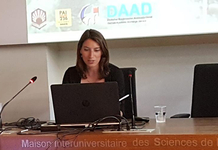Dr. Carmen González Gutiérrez
carmen.gonzalez_gutierrez@uni-erfurt.deAlumna (Max-Weber-Kolleg für kultur- und sozialwissenschaftliche Studien)
Kontakt
Postanschrift
Universität Erfurt
Max-Weber-Kolleg für kultur- und sozialwissenschaftliche Studien
Postfach 90 02 21
99105 Erfurt

Zur Person
Curriculum Vitae
- 09/2018-08/2019: MWK-FELLOWS COFUND Fellowship Program 2018-2019 (Max-Weber Kolleg, University of Erfurt, Germany).
- 05/2018 – current: Scholar in the Getty-sponsored workshop series “Mediterranean Palimpsests: Connecting the Art and Architectural Histories of Medieval & Early Modern Cities” (MCities).
- 03/2018 – 07/2018: DAAD Short-term grant at the Institut für Orientalistik, University of Bamberg (Germany).
- 07/2016 – 12/2016: Postdoctoral contract. “DIDACTA” Research Project. (University of Córdoba, Spain and Ministry of Economy and Competitiveness of Spain).
- 2011 – current: Active member of “Arqueología Somos Todos” Project for the scientific divulgation of cultural heritage and the research of widespread methodologies.
- 2016: International PhD in Archaeology. Universities of Córdoba, Huelva, Málaga, and Pablo de Olavide (Seville) (Spain).
Forschungsprojekt
The Islam and the city: building religious and urban spaces in the Middle Ages
Historical Islamic cities cannot be understood without mosques. They are essential elements for the daily life of Muslims, the clearest materialization of their culture, and landmarks of Muslim landscape. In the Middle Ages, their role in urban areas went beyond religious implications, as they were also related to the general organization and configuration of neighbourhoods. Mosques generated strong social interactions and movements around them, key to define and understand Islamic medieval settlements.
Despite their paramount importance, these implications have been rarely examined. Mosques have received very uneven treatment in research, which has traditionally focused only in major or more monumental ones. While Friday mosques are often mentioned, the more modest have been barely regarded by scholars. Although there are a few recent publications that vindicate their existence in al-Andalus, areas such as the central lands of Islam and the North of Africa tend to be disregarded. There is also a general lack of urban perspective in these works.
This background triggers this research action, which intends to offer a new perspective about the origin and evolution of Islamic cities from the analysis of religious spaces as the main referent in urbanism. One most ambitious objective is to understand how the medieval city was conceived and configured, and how it evolved along time.
This new multidisciplinary and crosscut perspective has already been successfully tested in Córdoba, Spain (Madinat Qurtuba), which has been a paramount focus of my research until now. Beyond its famous Great Mosque, I have explored deep and in detail the role that secondary mosques played in the urban development of Qurtuba from the 8th to the 13th c., highlighting the most recent archaeological data for this purpose. However, the case study of Córdoba was by no means my ultimate goal, but the stimulus to reflect on the morphology of Islamic cities along the Middle Ages. For that reason, the main focus of my research project at the Max-Weber-Kolleg is set on Madinat al-Zahra (Córdoba, Spain).
The objective is twofold. First, mosques of the Umayyad palatine city of Madinat al-Zahra will be analyzed to acquire a better knowledge about the city’s urban planning, spatial configuration and development during the Umayyad caliphate in the 10th c. Second, results obtained will be compared with the ones existing for Córdoba, in order to identify specific urban dynamics that may have defined cities’ urbanism. This comparison will draw a first outline of andalusí caliphal complexities in the 10th c., necessary to start raising comparative urban studies in the framework of Islamic cities beyond al-Andalus’ geographical area.
Publikationen
Books
- GONZÁLEZ GUTIÉRREZ, C. The Islamic city through its mosques: an overview from Córdoba (accepted at BRILL, currently in preparation).
- GONZÁLEZ GUTIÉRREZ, C. (2016): Las mezquitas de la Córdoba islámica: concepto, tipología y función urbana, Córdoba.
- GONZÁLEZ GUTIÉRREZ, C. (2012): Las mezquitas de barrio de Madinat Qurtuba: una aproximación arqueológica, Córdoba.

